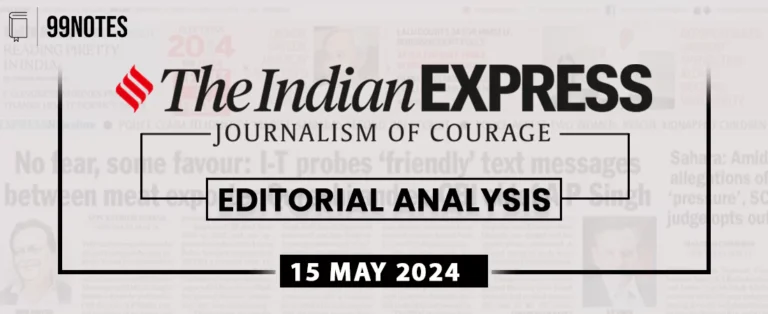12 September 2024 : Daily Current Affairs
1. Union Cabinet Approves PMGSY-IV: ₹70,125 Crore for 62,500 km of Rural Roads to Connect 25,000 Villages
(Source: Indian Express; Section: Express Network; Page: 10)
| Topic: GS2 – Governance – Government Policies |
| Context: |
| The Union Cabinet has approved the fourth phase of the Pradhan Mantri Gram Sadak Yojana (PMGSY-IV) to construct 62,500 km of all-weather roads, improving connectivity for 25,000 rural villages across India. |
Analysis of News:
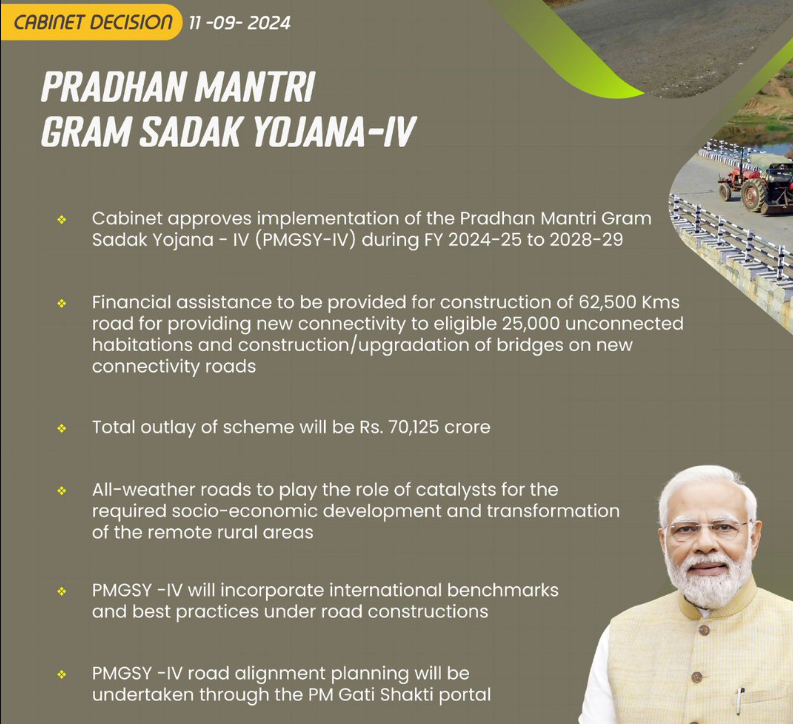
What is PMGSY?
- Launched on: 25th December, 2000.
- Objective: To provide connectivity, by way of an all-weather road to unconnected habitations.
- Eligibility: Unconnected habitations of designated population size (500+ in plain areas and 250+ in North-Eastern States, Himalayan States, Deserts and Tribal Areas as per 2001 census) in the core network for uplifting the socio-economic condition of the rural population.
- An Unconnected Habitation is one with a population of designated size located at a distance of at least 500 metres or more (1.5 km of path distance in case of Hills) from an All-weather road or a connected Habitation.
- Core Network: It is that minimal Network of roads (routes) that is essential to provide Basic access to essential social and economic services to all eligible habitations in the selected areas through at least single all-weather road connectivity.
Construction of Rural Roads: The Rural Roads constructed under the PMGSY will be in accordance with the provision of the Indian Roads Congress (IRC).
- IRC is the Apex Body of Highway Engineers in the country.
- The IRC was set up in 1934.
PMGSY – Phase I
- PMGSY – Phase I was launched in December, 2000 as a 100 % centrally sponsored scheme.
- Under the scheme, 1,35,436 habitations were targeted for providing road connectivity and 3.68 lakh km. for upgradation of existing rural roads in order to ensure full farm to market connectivity.
PMGSY – Phase II
- The Government of India subsequently launched PMGSY-II in 2013 for upgradation of 50,000 Kms of existing rural road network to improve its overall efficiency.
- While the ongoing PMGSY – I continued, under PMGSY phase II, the roads already built for village connectivity was to be upgraded to enhance rural infrastructure.
- The cost was shared between the centre and the states/UTs.
PMGSY – Phase III
- Phase III was approved by the Cabinet during July 2019.
- It gives priorities to facilities like:
- Gramin Agricultural Markets (GrAMs)
- GrAMs are retail agricultural markets in close proximity to the farm gate, that promote and service a more efficient transaction of the farmers’ produce.
- Higher Secondary Schools and
- Hospitals.
- Under the PMGSY-III Scheme, it is proposed to consolidate 1,25,000 Km road length in the States. The duration of the scheme is 2019-20 to 2024-25.
Introduction to PMGSY-IV
- The Union Cabinet approved the implementation of the fourth phase of the Pradhan Mantri Gram Sadak Yojana (PMGSY-IV), aimed at constructing 62,500 km of all-weather roads to provide connectivity to 25,000 rural villages across India. This phase covers the financial years 2024-25 to 2028-29.
Financial Allocation
- The total outlay for PMGSY-IV is ₹70,125 crore, with the central government contributing ₹49,087.50 crore and the states contributing ₹21,037.50 crore.
- This highlights the significant financial commitment to improving rural infrastructure.
Coverage and Objectives
- PMGSY-IV aims to connect 25,000 unconnected habitations, focusing on:
- Plains (population size 500+)
- Northeast and Hill States/UTs (population 250+)
- Special category areas (Tribal areas, Aspirational Districts/Blocks, Desert areas, and LWE-affected districts with populations of 100+).
- In addition, bridges will be constructed along the road alignments where necessary.
Socio-economic Impact
- The new roads will act as catalysts for socio-economic development in remote rural areas by improving access to education, healthcare, markets, and growth centers.
- This will enhance the overall quality of life for rural residents, promoting economic transformation in these regions.
| Challenges |
|
| Practice Question: The Union Cabinet has approved the fourth phase of the Pradhan Mantri Gram Sadak Yojana (PMGSY-IV) with an outlay of ₹70,125 crore for rural road construction. Discuss the potential impact of this initiative on rural development and connectivity, and suggest ways to maximize its benefits for remote areas. (250 words/15 m) |
2. Controversy Over Salt Pan Land Transfer for Dharavi Redevelopment Sparks Environmental Concerns
(Source: Indian Express; Section: Explained; Page: 17)
| Topic: GS3 – Environment |
| Context: |
|
Analysis of News:

What Are Salt Pan Lands?
- Salt pan lands are low-lying areas where seawater flows in and evaporates, leaving behind salt and minerals.
- These areas are crucial for flood protection in Mumbai, similar to the role of mangroves.
- Under the Coastal Regulation Zone (CRZ) notification of 2011, salt pans fall under CRZ-1B, which restricts economic activities except for salt extraction and natural gas exploration.
Development Pressure on Mumbai’s Salt Pan Lands
- With land scarcity in Mumbai, salt pans have become valuable for development. State governments have sought these lands for low-cost housing and other projects.
- Notably, past proposals by Devendra Fadnavis and Uddhav Thackeray aimed to use salt pans for slum relocation and infrastructure projects like metro car sheds.
Environmental Concerns
- Flooding Risk: Salt pans in low-lying areas prevent flooding by absorbing rainwater and seawater. Environmentalists warn that construction on these lands will lead to flooding in eastern suburbs such as Vikhroli and Bhandup.
- Biodiversity: Salt pans host various species of birds and insects. Environmentalists argue that urban development in these areas will harm the local ecosystem.
- Contradictions with Climate Plans: The government’s Mumbai Climate Action Plan acknowledges climate change risks, but development on salt pans contradicts efforts to mitigate flooding.
Quality of Life for Relocated Slum Dwellers
- Environmentalists question the suitability of salt pan land for housing, citing challenges like flooding, high costs for land preparation, and maintenance.
- Critics argue that the project’s high costs contradict its goal of providing affordable housing.
|
PYQ: Among the following, who is the Agaria Community? (2009) (a) A traditional toddy tappers community of Andhra Pradesh (b) A traditional fishing community of Maharashtra (c) A traditional silk-weaving community of Karnataka (d) A traditional salt pan workers community of Gujarat Answer: (d) |
| Practice Question: Critically examine the environmental and social implications of developing Mumbai’s salt pan lands for urban housing projects, particularly in the context of flood risk management and sustainable urban planning. (250 words/15 m) |
3. Madrasas ‘unfit’ for proper education, NCPCR tells SC
(Source – The Hindu, International Edition – Page No. – 6)
| Topic: GS2 – Social Justice – Education |
| Context |
|
Concerns Raised by NCPCR:
- Unsuitable Education Environment: Madrasas are deemed “unsuitable” for providing proper education due to their focus on religious texts rather than a comprehensive curriculum.
- Curriculum Issues: Textbooks in madrasas are said to promote Islamic supremacy and offer limited exposure to broader educational content. The inclusion of a few NCERT books is criticised as insufficient.
- Teacher Quality: Teachers predominantly use traditional methods, resulting in irregular and unregulated educational practices.
- Lack of Extracurricular Activities: Madrasas reportedly fail to provide essential social and experiential learning opportunities like field trips and other extracurricular activities.
- Violation of Constitutional Rights: Teaching Islamic education to non-Muslims in madrasas is seen as a violation of Article 28(3) of the Constitution, which prohibits forced religious instruction.
- Operational Concerns: Issues include opaque funding, non-compliance with land laws, and lack of a holistic environment conducive to growth and learning.
Way Forward:
- Curriculum Reform: Revise madrasa curricula to include a balanced and comprehensive educational content that integrates national standards.
- Teacher Training: Improve teacher training and ensure regularisation of teaching practices.
- Extracurricular Integration: Implement structured extracurricular and social activities to enhance overall student development.
- Regulatory Oversight: Establish clearer guidelines for madrasa operations, funding transparency, and adherence to land laws.
- Constitutional Compliance: Ensure that madrasa education complies with constitutional rights, particularly regarding non-Muslim students.
- Monitoring and Evaluation: Regularly monitor and evaluate madrasa performance to ensure adherence to educational standards and rights.
| Practice Question: Discuss the concerns raised by the National Commission for Protection of Child Rights (NCPCR) regarding the education system in madrasas. Evaluate the implications of these concerns on the educational rights of children and suggest measures to address these issues. (150 Words /10 marks) |
4. Organ-on-chip tech could boost BioE3 objective to personalise medicine
(Source – The Hindu, International Edition – Page No. – 7)
| Topic: GS3 – Science and Technology |
| Context |
|
Organ-on-Chip Technology:

- Definition: Organ-on-chip technology involves microfluidic devices that replicate the physiological functions of human organs on a miniature scale.
- Components: Combines living cells, tissues, and engineered microenvironments to mimic the complex interactions within human organs.
- Purpose: Provides a more accurate and controlled in vitro platform for studying organ-specific responses and disease mechanisms.
| ‘BioE3’ Policy: |
|
|
Advantages:
- Enhanced Accuracy: Offers more precise simulations of human organ functions compared to animal models, improving the relevance of experimental results.
- Cost-Efficiency: Reduces the time and financial investment needed for drug development by providing quicker and more reliable testing platforms.
- Ethical Benefits: Minimises or eliminates the need for animal testing, addressing ethical concerns related to animal welfare.
Applications:
- Drug Development: Used to test drug efficacy and safety, reducing the likelihood of failures in later clinical trials.
- Disease Research: Helps model diseases and study their progression, enabling the development of targeted therapies.
- Personalised Medicine: Facilitates the creation of personalised treatments by integrating individual genetic information into drug testing and development processes.
| Practice Question: Explain the concept of organ-on-chip technology and discuss its key advantages. How does this technology improve drug development and personalised medicine compared to traditional methods? (150 Words /10 marks) |
5. Release of the Report of the Expert Group Report on ‘Future Pandemic Preparedness – A Framework for Action’
(Source – https://pib.gov.in/PressReleseDetail.aspx?PRID=2053759 )
| Topic: GS2 – Social Justice – Health |
| Context |
|

Key Insights About The Report:
- Objective: NITI Aayog’s report, Future Pandemic Preparedness and Emergency Response—A Framework for Action, provides a blueprint for managing future pandemics and public health emergencies.
- WHO Warning: 75% of future public health threats are predicted to be zoonotic, necessitating robust preparedness.
- Key Learnings from COVID-19: The group studied national and global responses to COVID-19, identifying strengths and gaps.
- Crucial 100-Day Response: The report emphasises that the first 100 days of an outbreak are critical for effective management.
- Four Pillars of Recommendations:
- Governance, Legislation, Finance, and Management
- Data Management, Surveillance, and Predictive Warning Systems
- Research, Innovation, Manufacturing, Infrastructure, and Capacity Building
- Partnerships and Community Engagement
- Focus on Digital Tools: Digital systems used during COVID-19 for vaccination and data management were highlighted as key success areas.
| PYQ: Critically examine the role of WHO in providing global health security during the Covid-19 pandemic. (150 words/10m) (UPSC CSE (M) GS-2 2020) |
| Practice Question: Discuss the key components of India’s future pandemic preparedness framework. Also evaluate the role of governance, technology, and public-private partnerships in ensuring an effective response to future health crises. (250 words) (150 Words /10 marks) |
Prelims Facts
1. Cabinet approves health cover for all aged 70 and above
(Source – The Hindu, International Edition – Page No. – 6)
| Context |
| The Union Cabinet, led by Prime Minister Narendra Modi, approved extending Ayushman Bharat Pradhan Mantri Jan Arogya Yojana (AB PM-JAY) coverage to all senior citizens aged 70 and above, providing ₹5 lakh health insurance, enhancing benefits for elderly citizens. |
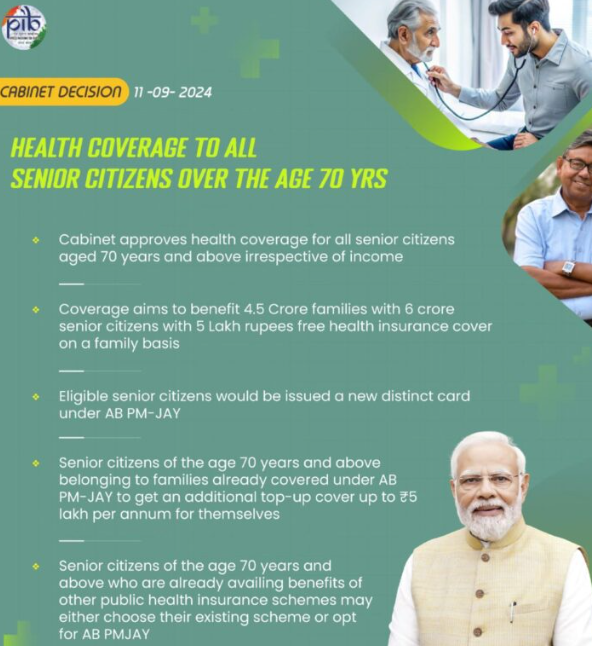
Analysis of the news:
- The Union Cabinet approved extending Ayushman Bharat Pradhan Mantri Jan Arogya Yojana (AB PM-JAY) health coverage to all senior citizens aged 70 and above, regardless of income.
- The scheme will cover approximately 6 crore senior citizens across 4.5 crore families with ₹5 lakh free health insurance per family.
- Eligible seniors will receive a new distinct card under the scheme.
- Those already covered under AB PM-JAY will get an additional ₹5 lakh annual top-up for themselves.
- Seniors with other public health schemes like Central Government Health Scheme (CGHS) or Ex-Servicemen Contributory Health Scheme (ECHS) can choose between their existing scheme and AB PM-JAY.
- Private health insurance holders will also be eligible for AB PM-JAY benefits.
2. Cabinet approves ₹10,900 cr. scheme for e-mobility push
(Source – The Hindu, International Edition – Page No. – 12)
| Context |
|
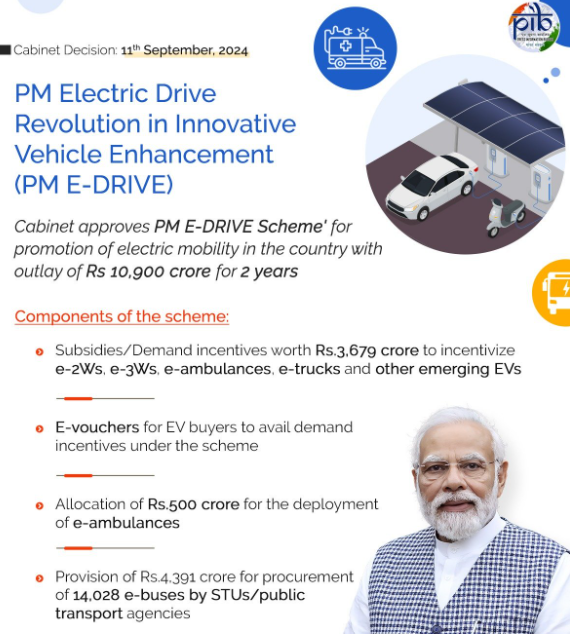
Analysis of the news:
- The Union Cabinet approved the PM Electric Drive Revolution in Innovative Vehicle Enhancement (PM E-Drive) scheme with an outlay of ₹10,900 crore.
- The scheme will last for two years and aims to address range anxiety among electric vehicle (EV) buyers.
- It includes subsidies or demand incentives worth ₹3,679 crore for electric two-wheelers (e-2Ws), three-wheelers (e-3Ws), ambulances, and trucks.
- ₹4,391 crore will be allocated for procuring e-buses by state transport undertakings in 9 major cities with populations over 40 lakh.
- ₹2,000 crore will be set aside for establishing over 72,000 charging stations in high EV penetration cities and specified highways.
- The scheme aims to boost EV adoption and infrastructure development across India.
3. Afghanistan set to begin work on TAPI pipeline
(Source – The Hindu, International Edition – Page No. – 15)
| Context |
|
TAPI Pipeline:

- The TAPI (Turkmenistan-Afghanistan-Pakistan-India) pipeline is a 1,814-kilometre project designed to transport 33 billion cubic metres of natural gas annually.
- Known as the ‘Peace Pipeline’, it begins at the Galkynysh gas field in Turkmenistan, passes through Afghanistan and Pakistan, and reaches Fazilka in India.
- At full capacity, the pipeline will allocate gas to Afghanistan (5%), Pakistan (47.5%), and India (47.5%) over a 30-year period.
- The project encompasses procurement, installation, and operation of the pipeline and associated facilities in Afghanistan and Pakistan.
- Conceived in the 1990s, an inter-governmental agreement was signed in 2010, with subsequent agreements in 2013 and a groundbreaking ceremony in Herat in 2018.
- Financed by the Asian Development Bank and Turkmenistan’s $700 million loan from the Islamic Development Bank, with an initial $300 million investment from the three other countries.
4. Union Cabinet Approves ₹2,000 Crore ‘Mission Mausam’ to Boost India’s Weather Forecasting Capabilities
(Source: Indian Express; Section: Express Network; Page: 10)
| Context: |
| The Union Cabinet approved Mission Mausam, a major initiative to upgrade India’s weather forecasting capabilities, with a budget of ₹2,000 crore for the first two years. |
Analysis of News:

Objective of the Mission
The mission aims to enhance weather surveillance, forecasting, and modelling to benefit key sectors such as:
- Agriculture
- Aviation
- Defence
- Disaster Management
- Tourism
- Health
Coverage and Focus Areas
- Mission Mausam will comprehensively address all aspects of weather services.
- A similar initiative, Mission Monsoon, was launched in 2012, targeting long-range monsoon forecasts.
Current Accuracy Levels
- Heatwave prediction (up to 24 hours in advance) accuracy: 97.99%
- Heavy rainfall forecasts accuracy: 80%
Key Institutions Involved
Mission Mausam will be spearheaded by three Ministry of Earth Sciences-funded institutions:
- India Meteorological Department (IMD)
- Indian Institute of Tropical Meteorology, Pune
- National Centre for Medium-Range Weather Forecasting, Noida
Goals
- Provide accurate, timely forecasts at various scales.
- Issue alerts for extreme weather events.
- Implement interventions for fog, hail, and rainfall management.
- Build capacity and train personnel.
Progress Since 2014
- There has been a five-fold increase in the deployment of weather radars, especially in the Himalayan region.
5. 40% of Amazon’s Most Crucial Carbon-Storing Areas Remain Unprotected, New Data Reveals
(Source: Indian Express; Section: Explained; Page: 17)
| Context: |
|
Analysis of News:
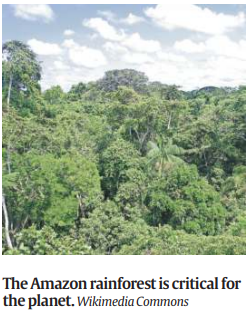
Carbon Storage and Deforestation Risks
- These unprotected regions store vast amounts of carbon, which could be released as greenhouse gases if destroyed by fire or logging.
- This makes them critical in mitigating global warming.
Satellite Data and Findings
- Amazon Conservation, in collaboration with the satellite imaging company Planet, used laser technology and machine-learning models to analyze above-ground vegetation.
- The study found that 61% of peak carbon areas are protected, while the remaining 39% are not.
Country-Specific Protection Levels
- Brazil, Suriname, and French Guiana: Only 51% of key carbon areas are protected.
- Peru: Protects a higher proportion but has left some areas vulnerable to logging.
Significance of the Amazon
- The Amazon holds approximately 71.5 billion tonnes of carbon, nearly double global CO₂ emissions in 2022.
- Though it still absorbs more carbon than it emits, this balance is fragile, and its potential shift from a carbon sink to a carbon source could have catastrophic consequences for global climate.
6. IAF AIRCRAFT SET COURSE FOR EXERCISE EASTERN BRIDGE VII AT OMAN
(Source – https://pib.gov.in/PressReleseDetail.aspx?PRID=2053702 )
| Context |
|
Exercise Eastern Bridge VII:
- Exercise Eastern Bridge VII is the seventh edition of the bilateral air exercise between the Indian Air Force (IAF) and Royal Oman Air Force (RAFO).
- Scheduled from 11 to 22 September 2024 at Masirah Air Force base, Oman.
- The IAF contingent includes MiG-29s, Jaguars, and C-17s.
- Aims to improve interoperability, tactical proficiency, and operational readiness between the two air forces.
- Focuses on joint training missions, including complex aerial manoeuvres, air-to-air and air-to-ground operations, and logistical coordination.
- Enhances both forces’ ability to operate together in diverse scenarios, reflecting evolving strategic interests and defence needs.
- Offers an opportunity for both teams to share expertise and benefit from mutual operational experience.





